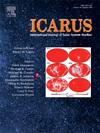磷酸盐表明土卫二上的海水pH值很高
IF 3
2区 物理与天体物理
Q2 ASTRONOMY & ASTROPHYSICS
引用次数: 0
摘要
土卫二为我们探索另一个世界海洋的化学成分提供了最好的机会。在这里,我们进行了地球化学建模,以显示在土卫二羽流的冰粒中发现的磷酸盐物种的分布如何对宿主溶液的pH值提供非常直接的约束。HPO4/PO4种的比值可以作为pH的指标。我们发现了中度碱性水(pH值10.1-11.6)的证据,比目前估计的土卫二海洋pH值(~ 8-9)要碱性得多。然而,如果二氧化碳根据其平衡溶解度从海水中溶解,则磷酸盐的pH范围与羽流中测量的CO2/H2O比一致。一个简单的能量平衡可以用来量化土卫二虎纹内部气体传输过程中的挥发分;我们推断,在液-气界面和气体离开地下的地方之间的运输过程中,约83%的水蒸气以冰的形式被除去。我们还探讨了二氧化碳脱气如何导致海水表观pH值的增加。我们生成的地图允许组合的pH值和溶解的无机碳浓度的水源水为广泛的方案。我们的首选解释受到观测到的热通量的限制,意味着海水中的二氧化碳脱气最小。因此,磷酸盐所记录的pH值应该与海洋的pH值非常接近;我们的最佳估计值是pH ~ 10.6。如此高的pH值似乎反映了富含Na, Mg或Fe(II)的硅酸盐与海水广泛相互作用的主要作用。如果pH值太高(10.5),二氧化硅纳米颗粒不会形成或随后会溶解。本文提出的放气模型提供了一种新的途径来量化挥发性物质的溶解浓度。本文章由计算机程序翻译,如有差异,请以英文原文为准。
Phosphates reveal high pH ocean water on Enceladus
Enceladus offers our best opportunity for exploring the chemistry of an ocean on another world. Here, we perform geochemical modeling to show how the distribution of phosphate species found in ice grains from Enceladus's plume provides a very straightforward constraint on the pH of the host solution. The ratio of HPO4/PO4 species serves as a pH indicator. We find evidence of moderately alkaline water (pH 10.1–11.6)—significantly more alkaline than current estimates (∼8–9) of the pH of Enceladus's ocean. Nevertheless, the pH range from phosphates is consistent with the CO2/H2O ratio measured in the plume if CO2 exsolves from ocean water according to its equilibrium solubility. A simple energy balance can be used to quantify volatile fractionation during gas transport inside Enceladus's tiger stripes; we deduce that ∼83 % of water vapor is removed as ice during transport between the liquid-vapor interface and where gases exit the subsurface. We also explore how CO2 degassing may lead to an increase in the apparent pH of ocean water. We generate maps of allowed combinations of pH and dissolved inorganic carbon concentration of the source water for a wide range of scenarios. Our preferred interpretation, constrained by the observed heat flux, implies minimal CO2 degassing from ocean water. Hence, the pH recorded by phosphates should closely approximate that of the ocean; our best estimate is pH ∼10.6. Such a high pH seems to reflect a major role of silicates enriched in Na, Mg, or Fe(II) interacting extensively with ocean water. Silica nanoparticles would not form or would subsequently dissolve if the pH is too high (>10.5). The outgassing model presented here provides a new path to quantify the dissolved concentrations of volatile species.
求助全文
通过发布文献求助,成功后即可免费获取论文全文。
去求助
来源期刊

Icarus
地学天文-天文与天体物理
CiteScore
6.30
自引率
18.80%
发文量
356
审稿时长
2-4 weeks
期刊介绍:
Icarus is devoted to the publication of original contributions in the field of Solar System studies. Manuscripts reporting the results of new research - observational, experimental, or theoretical - concerning the astronomy, geology, meteorology, physics, chemistry, biology, and other scientific aspects of our Solar System or extrasolar systems are welcome. The journal generally does not publish papers devoted exclusively to the Sun, the Earth, celestial mechanics, meteoritics, or astrophysics. Icarus does not publish papers that provide "improved" versions of Bode''s law, or other numerical relations, without a sound physical basis. Icarus does not publish meeting announcements or general notices. Reviews, historical papers, and manuscripts describing spacecraft instrumentation may be considered, but only with prior approval of the editor. An entire issue of the journal is occasionally devoted to a single subject, usually arising from a conference on the same topic. The language of publication is English. American or British usage is accepted, but not a mixture of these.
 求助内容:
求助内容: 应助结果提醒方式:
应助结果提醒方式:


